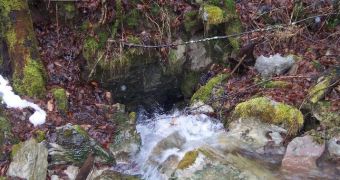Intermittent springs represent waters that flow at intervals, apparently not dependent upon rain or drought. They are usually found in calcareous areas.
One way these springs function is based on the principle of the simple siphon. A grotto fills with water via rainfall or snow melting. The filling of the grotto is made through numerous cracks and alimentation canals. The water's elimination out of the grotto is made through an evacuation canal, which has the shape of a siphon. The width of the siphon tube is twice larger than that of the alimentation canals. The filling period of the grotto depends on the duration and intensity of the rainfall. Usually, its filling lasts several hours and, when the water level has reached the curvature of the siphon, first a whistle is heard, a signal that the air has been ejected from the canal, than the water's flow follows. This lasts 15-20 minutes. During the drought periods, the refilling can last up to one day and even more.
A more complicated mechanism is that of the intermittent springs functioning on the principle of the double siphon. These springs have 2 grottoes, a larger upper one and a smaller lower one, united through a connecting siphon. The alimentation canals fill the upper grotto. The connecting siphon has a diameter larger than the alimentation canals. A second siphon releases the water from the second lower grotto, and this one has a diameter larger than the connecting siphon.
In this case, the larger upper grotto must be filled first. This process may last just a few hours during rainy periods. The water is evacuated into the lower grotto, an operation that may last 30-40 minutes, until reaching the curvature of the second siphon, and the first release takes place, lasting 5-10 minutes. Then, a second refill of the second grotto follows, produced also in 30-40 minutes, and subsequently the second gush of water is produced, lasting 5-10 minutes. Thus, the grottoes are filled in 3-4 hours and the water is released in maximum 2 hours. During drought periods, the refilling can last for days, influencing the release period, both in the large and small grottoes.

 14 DAY TRIAL //
14 DAY TRIAL //